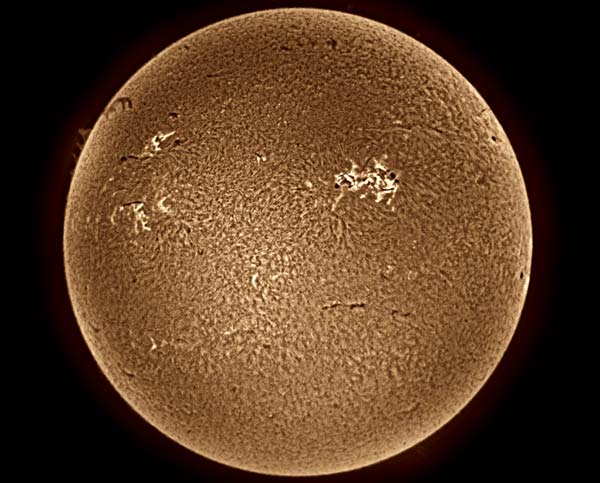Solar Astronomy

Normally the sun looks like a bright disc of uniform colour. But view it through a hydrogen-α filter and it suddenly transforms into a bizarre alien object. And amazingly you don't need a billion dollar satellite to view the sun this way. A $500 telescope is good enough. Follow that link and you'll see pictures actually taken with that telescope (and subsequently image processed...). You can clearly see solar granulation, filaments, prominences and some of the structure around sunspots.
The problem with solar viewing is that the Sun pumps out vast quantities of energy fairly indiscriminately following a Planck distribution. This tends to overwhelm phenomena that emit at a specific wavelength. So you need an incredibly narrow band pass filter that only allows light at a given wavelength to be transmitted. In this case we were using a filter whose bandwidth was less than 0.1 nanometre to view emissions at 656.3nm caused by electrons dropping from the third to the second energy level in hydrogen atoms.
Making filters this good is itself is an amazing feat. What material could possibly have the correct properties to allow that degree of selectivity? As far as I can make out from the sales blurb, the filter on this telescope is in fact a Fabry-Pérot etalon. Essentially it's two highly reflective (but still slightly transmissive) parallel layers. Consider light travelling perpendicularly through such layers. It might travel straight through. Or it might bounce 2n times before continuing on its way. So the light we see is the sum of light that has bounced 0, 2, 4, 6, ... times. If all of these reflected rays are in phase they'll constructively interfere. Otherwise the infinite sum will be over widely varying phases resulting in destructive interference. So by choosing the correct spacing between the layers we can ensure that only one wavelength (and higher harmonics of it) will be transmitted. You can imagine the difficulty in getting the precise layer separation and that's why these filters can cost many thousands of dollars. And fabrication isn't the only problem - it also needs to be stable even though it has solar energy falling directly onto it.
Anyway, I'm so taken with this solar astronomy stuff I'm going to read this book. And I'll leave you with this link to some even more amazing pictures of the Sun.
(BTW In lieu of having a way to attach my camera to the solar telescope I borrowed the picture from here. Note that the comment is now out of date, the solar neutrino problem has since been solved.)
Labels: astronomy
0 Comments:
Post a Comment
<< Home